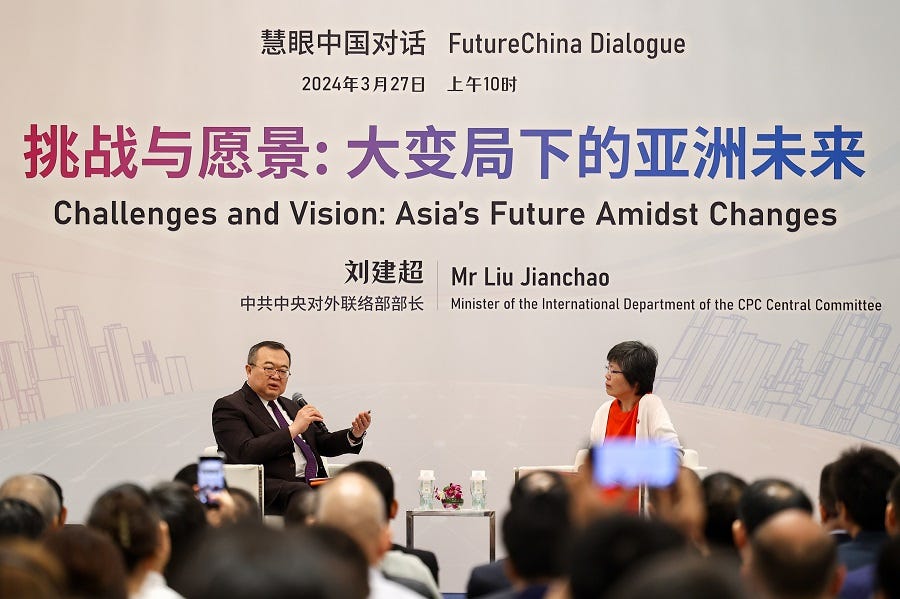Lost in translation, underestimating China's roadmap, farmers' subway
Selection of China backgrounds | perspectives | context | news
China21 Journal regularly selects a number of publications from (social) media for more background, perspective, context or news about China.
#cross-cultural-communication #culture #learning
‘lost in translation’
China’s Liu Jianchao shows his tact in communicating with the outside world
Highlights of the FutureChina dialogue in Singapore on March 27 with Mr. Liu Jianchao, Minister of the International Department of the CPC Central Committee and host Lee Huay Leng, editor-in-chief of Singapore’s Chinese Media Group (SPH Media).
Published in ThinkChina, and English language e-magazine with a China Focus in Singapore, March 28, 2024
“In a dialogue hosted by Business China, Lianhe Zaobao and ThinkChina on March 27 in Singapore, senior Chinese diplomat Liu Jianchao showed his skill and eloquence in responding to tricky questions about China.
In dealing with the questions posed by the host, media veteran and editor-in-chief of Singapore’s Chinese Media Group Lee Huay Leng, this experienced Chinese diplomat doled out a repertoire of puns, rhetorical questions and even self-deprecation, handling the questions in a gentle yet firm manner.
He explained that “a discerning eye means to be unique”, reminding that if everyone’s perspective on a matter stems only from one angle, they may draw an inaccurate observation.
Understanding the language in China’s context
On the issue of China’s communication with the external world, Lee raised that much of China’s choice of words makes it distant from the rest of the world, and that to understand China would mean having to read between the lines, resulting in foreign readers often “understanding the words but not the meaning”. Participants laughed seemingly in agreement.
Liu took a pause, with a hint of helplessness on his face, before throwing the question back at Lee, skillfully deflecting it with a smile: “What should we do then? Should Singapore send more students to study abroad in China?”
His response once more drew laughter from the audience.
But Liu was quick to offer a serious reply, saying that all countries have their own political environment, and that China’s own political environment, language and structure — in effect the “Chinese characteristics” so heavily delineated by China — encompasses its socialist market economy, Chinese-style modernisation and so forth. So the issue of language should be seen through the lenses of its political environment.
The diplomat, who is fluent in English, then changed tack and said, “Even though I have been learning English for a very long time, there are times when I might not fully understand Western languages.”
Liu stated that China does not reject advanced things from other countries, and would not refuse to learn from others, including learning about Western economic and social terminologies.
He added, “Other countries could also try to put themselves into China’s context to learn; this would help in understanding and in boosting confidence in China.”
Hence, where does the problem lie on the issue of China communicating with the external world? While he was not overbearing, Liu’s response implied, can the West take it seriously when it comes to learning about China’s context?
Liu even self-deprecatingly stated that the task of communicating is a tall order, and that “if today you realise that even after hearing from me Liu Jianchao, you are still unclear about things, I am to blame”.”
Read full article and watch video of the dialogue
#china-direction #china-strategy
‘underestimating China’s industrial roadmap’
Why China’s plan for ‘new productive forces’ should make the West sit up
Shirley Ze Yu, Political Economist Focused on China in the Emerging World | Professor | Author
Op-ed published in South China Morning Post, March 16, 2024
“Why China’s plan for ‘new productive forces’ should make the West sit up.
It’s the successor to the grossly underestimated ‘Made in China 2025’ strategy, which spawned China’s dominance in electric cars, green tech and other high-end industries.
In China’s annual parliamentary meetings (Two Sessions, last month), developing “new quality productive forces” topped the agenda. A twist on Marxist theorisation, new quality productive forces simply mean new drivers of economic – and defense – growth, powered by frontier technologies.
Such new forces can span from infotech, biotech, artificial intelligence, quantum computing, new energy and new materials, to deep space, deep ocean and deep mind.”
Promotion video 25th China Hi-Tech Fair Shenzhen, China, November 2023
Shirley Ze Yu warns in her op-ed for a repeated underestimation by the West of China’s new strategic roadmap “new productive forces”, similar to the reception of the 2015 strategic policy plan “Made in China 2025”.
And not only underestimation is subversive but also a critical review in the West is essential. A consideration on how to approach the new phase of China’s industrial development as high-tech sanctions and decoupling policies in recent years did not restrain China from becoming a global leader in 37 out of 44 critical technologies such as space, robotics, energy, environment, biotechnology, artificial intelligence or defence.
The world currently witnesses the results of the “Made in China 2025” strategy with green-tech (solar panels and wind farms), electric vehicles, communication, an own space station among many others but also the leading advancements in global logistic and digital infrastructure for Chinese e-commerce (Shein, Temu) and social media (Tiktok).
China’s new decade of “new productive forces” should be carefully monitored and acted or engaged upon by the West as China will continue to move forward in new revolutionary industrialization. And more important than acting upon is to draw own roadmaps of technological advancements and regulations.
Read more about what “new productive forces” means here ‘China accelerates building of new quality productive forces’.
And a peek into the fully automated factory of Xiaomi’s first electric vehicle SU7, opened end of last month in Beijing (Xiaomi is merely known in the West for Mi smartphones).
#connectivity #infrastructure #society #rural-economy #poverty-alleviation
‘farmers’ subway : why infrastructure and connectivity matters’
Affectionately known as the 'bamboo basket carrying farmers light rail', the rapid transit line 4 in Chongqing opened in June 2022, connecting the rural Shichuan Town in Yubei district with the downtown area (32km).
Before the opening, farmers were selling their vegetables locally, with fewer customers and usually at lower prices. Since the opening of line 4, more and more farmers have found their way selling their produce downtown.
The railway management has also adjusted their services to the farmers by using portable hand scanning devices to go through security as the baskets are inconvenient to put onto the security machine (or do not fit). Shishuan station regularly opens earlier than standard opening times to facilitate farmers flocking to town in the early morning.
Since this month, announcements in the station are also in the local Chongqing dialect as some of the elderly farmers have difficulty understanding Putonghua, also called (Standard) Mandarin, China's official language.
Photo 1 : Snapshot of Promotion video 25th China Hi-Tech Fair Shenzhen, China, November 2023
Photo 2 : ThinkChina
Video 1 : Douyin (Tiktok)
For more insight and depth on China, browse China21 Journal essays and articles





